
 |
|
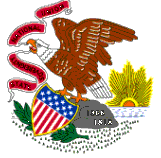













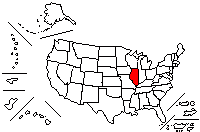
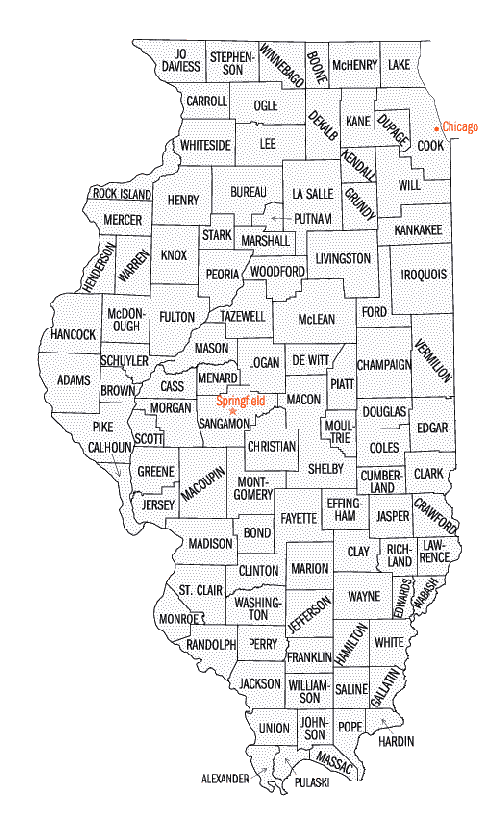

Illinois |
Illinois
Por vuestros gentiles |

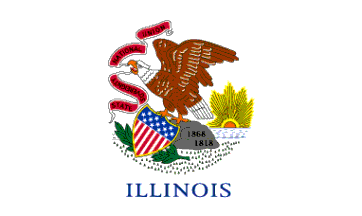
Flag:
The Illinois flag is a simple representation of the Great Seal
of Illinois against a white background. In 1969, the General Assembly
voted to add the word "ILLINOIS" under the Great Seal of the flag.
The State's
name was added to the flag to ensure that people not familiar
with the Great
Seal of Illinois would still recognize the banner. Flag adopted 1915.
Bandera:
La bandera de Illinois is una representación simple del Gran
Sello de Illinois colocado en un fondo blanco. En el 1969, la Asamblea
General emitió un voto para añadir la palabra "ILLINOIS" debajo del
Gran Sello de la bandera. El nombre del estado fué añadido a la bandera
para asegurar que las personas que no estaban familiarizado con el
Sello de Illinois lo reconocieran en la bandera. La bandera fué adoptata
en el 1915.

Illinois
Capital City: Springfield
National: Illinoisans
Admission to Statehood: December 3, 1818
Border States: Indiana / Iowa / Michigan / Kentucky / Missouri / Wisconsin
Motto: State Sovereignty, National Union
These words were inscribed
on the original state seal adopted in 1818. The seal that came into use in
1868.
Nickname: Prairie State
Origin of state's name: Named by USA citizanes. Algonquin Indian for "warriors"
Illinois (se pronuncia íl-li-nois en inglés y español)
Ciudad Capital: Springfield (Campo Primavera)(se pronuncia S-príng-fild en inglés y español)
Gentilicio: Illinoieños (Il-li-noiéños)
Admición como estado: 3 de diciembre de 1818
Estados limítrofes: Indiana / Iowa / Michigan / Kentucky / Missouri / Wisconsin
Lema: Soveranía estatal, Unión Nacional.
Estas palabras fueron inscrita en el sello original
del estado adoptado en el 1818. El sello empezó a ser utilizado en 1868.
Cognómento: Estado Pradera
Origen del nombre: Nombre dado por ciudadanos americanos. Palabra india para guerreros

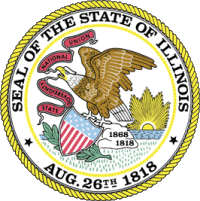
The Seal:
The Great Seal of the State of Illinois features an eagle carrying
a shield in its talons. Thirteen stars and thirteen stripes on t
he shield represent the original thirteen states of the Union.
This basic design has survived through several modifications
since it was first conceived in 1818, the year that Illinois
gained statehood. The date of the state's first constitution,
Aug. 26, 1818, appears along the bottom arc of the circle, and 1818,
the year of statehood, displays on the seal below 1868, the year the
current seal was adopted.
But what about that banner in the eagle's beak? And why is one of
the words on the banner upside down? Here's where we get a hint of
some intrigue and controversy...
When the banner first appeared on the seal, it read
"State Sovereignty, National Union". But then, in 1867,
the Secretary of State Sharon Tyndale decided that some c
hanges should be made to the seal. Under Illinois law,
the Secretary of State is the guardian of the seal, but
changes need to be authorized by the General Assembly.
So the Secretary of State approached Senator Allen Fuller
with the idea of changing the seal, and the Senator brought
the proposal to the General Assembly. Now this was all happening
at the time when the Civil War and issues of state's rights were
still fresh in the nation's mind, and one of the changes that
Tyndale had proposed was a change to the wording on that banner
in the eagle's beak. The Secretary's proposal was to have the
words on the banner read "National Union, State Sovereignty",
instead of "State Sovereignty, National Union". The General
Assembly disagreed, and decided that the wording should remain
unchanged. So, the Secretary went along with the General Assembly's
decision and made the minor changes that were agreed upon... Almost.
Perhaps it was a twinkle in the Secretary of State's eye
(or maybe a bit of spite?), but the Secretary made one small change
to that banner that still exists today -- the word "Sovereignty",
which previously was as readable as any of the words on the banner,
ended up being turned upside down on the 1868 seal. Intentional?
Playful? Spiteful? Who knows?
El Sello:
El Gran Sello del Estado de Illinois presenta a un águila llevando
un escudo en sus garras. Trece estrellas y trece líneas en el escudo
representan los trece estados originales de la unión.
Este diseño básico ha sobrevivido a varias modificaciones desde que
fué creado en el 1818, el año en que Illinois obtuvo la estadidad.
La fecha de la primera constitución del Estado, 26 de agosto de 1818,
aparece en la parte de abajo y 1818, el año de la estadidad, aparece en el
sello bajo el 1868, la fecha en que el Sello fué adoptado.
Pero... que pasa con el banderín del pico del águila? Y por que una de las
palabras en el banderín esta al revés? ...
Cuando el banderín apareció en el sello por privera vez, este leía,
"Estado Soverano, Unión Nacional". Pero entonces, en el 1867, el Secretario
de Estado Sharon Tyndale decidió que algunos cambios debería ser hecho
en el Sello. Bajo las leyes de Illinois, el Secretario de Estado
es el guardián del Sello, pero los cambios necesitan la autorización de
la Asamblea General. Entonces el Secretario de Estado se acercó al Senador
Allen Fuller con la idea del cambio del Sello y el Senador lo presentó
a la Asamblea General. Todo esto pasó en la fecha de la Guerra civil y la
discución de los derechos de los estados estaban fresca en la mentede las
Naciones, y uno de los cambios que Tyndale había propuesto fué un cambio
en la redacción en el banderín. El Secretario propuso que las palabras
en el banderín leyeran "Unión Nacional, Estado Soverano",
en vez de "Estado Soverano, Unión Nacional". La Asamblea Genera estubo
en desacuerdo, y decidió que la redacción permanecería sin cambio. Entonces,
el Secretario se adelantó a la Asamblea General e hizo unos cambios menores que
estubiera acorde con la desición... Casi.
Posiblemente se le escapó a los ojos del Secretario de Estado (o puede
ser que por despecho?), pero el Secretario hizo un cambio menor en el
banderín que continua hasta hoy -- la palabra Soverana,
que previamente fué legible con cualquier palabra del banderín, terminó
escrita al revés en el Sello de 1868. Intencional? sentido de humor?
desquite? Nadie sabe.

History
Illinois is a leading agricultural, manufacturing,
and urban state of the north central region of the
United States. It is bordered by Wisconsin on the
north, Lake Michigan on the northeast, Indiana on the
east and southeast, and Kentucky on the south. The Ohio
River follows its southern border, and the Mississippi
in the west and southwest of the state lies along its borders
with Iowa and Missouri. Inhabited thousands of years ago by
Indians, Illinois was explored by the French Jesuit missionary
Jacques Marquette and frontiersman Louis Jolliet, who reached
the area on June 20, 1673. The French changed the Indian name
for the area, Illiniwek, meaning "the men," to Illinois.
Illinois became a state on Dec. 3, 1818. Although the 25th
largest state in size, its population is ranked only sixth-largest
of all states, and its growth rate has been non-existent
or very low since the 1980s. Springfield became the capital
in 1837. Since 1850, Illinois has been a major state in all
economic sectors. Now it faces the problems of increasing
urbanization and interregional economic competition.
Thousands of years before the French reached Illinois,
Paleo-Indians, a nomadic people, and their descendants,
archaic Indians, had explored Illinois. The culture of these hunters,
dated before 5000 BC, can be studied at the Modock Rock
Shelter in Randolph County. Woodland Indians were their
descendants. By AD 900, Middle Mississippi Indians, who
succeeded the Woodland Indians, built large earthen mounds
and developed complex urban areas. These cities disappeared
possibly because of overpopulation, disease, and exhaustion of
resources. The descendants of the Mississippians were the Illiniwek
tribes of the 17th, 18th, and 19th centuries. After years of
losing land and wars to other Indian groups and European colonists,
the Illiniweks were moved to a Kansas reservation.
The French controlled areas along the Mississippi River
valley in the American Bottoms between Cahokia and Kaskaskia.
Their occupation, from about 1675 to 1763, left few lasting marks,
as did the ineffective British rule. European control
was ended by the U.S. militia of George Rogers Clark in 1778,
whereupon Virginia claimed Illinois as within its territory.
The Northwest Ordinance of 1787 charted this region and organized
counties, and in 1809 the Territory of Illinois was created.
During the early years of settlement by fur trappers, southern
Illinois was the focus of migration to the area, especially
along the Mississippi River valley and the Wabash and Ohio rivers.
Granting of statehood in 1818 was controversial. The population
numbered less than the required 60,000. Moreover, in order to
include the Chicago port area, territorial representatives induced
the U.S. Congress to draw the Illinois border 51 miles to the
north of the original boundary as delimited by the Northwest
Ordinance. The first capital was Kaskaskia, followed by Vandalia,
along the Kaskaskia River, which held the position for 20 years.
After strong pressure from Abraham Lincoln, the capital was moved
to Springfield by an 1837 legislative vote.
Early statehood problems engulfed Illinois. In the 1830s the state
was near bankruptcy because of government financing of canals and
railroad construction. The Black Hawk War in 1832 was fought by
the Indians and newly arrived settlers over possession of Illinois
land. Disease was rampant and death common. Adherents to Mormonism,
who had migrated from Missouri in 1839, were charged with many
illegalities and finally driven from the state after their leader,
Joseph Smith, had been murdered in 1844.
The Civil War caused mixed loyalties among Illinoisans, many of
whom were first- or second-generation Southerners. However, many
took pride in the fact that the Union was led by a native son,
Lincoln, and the state provided 250,000 soldiers to the Union army.
It also was the weapons manufacturer, supplier of iron products,
and major grain and meat supplier for the North.
By 1880, Illinois had become the fourth most populous state. It
was a leader in grain production and manufacturing. Large-scale
European immigration provided labor to mine coal, run steel mills,
and enhance the economy and culture of the state. By 1920, Illinois
was counted among the foremost states in nearly every significant
growth variable--coal mining, industry, farming, urbanization,
transportation, and wholesaling. Its leadership was achieved
despite the economic slumps of the 1880s, 1890s, and early 1900s;
the labor disputes in coal mining and railroading; the Chicago fire
of 1871; and the problems caused by organized crime. World Wars I
and II boosted the economy of Illinois, which soon had five ordnance
depots and numerous military training camps.
Illinois es un estado líder en la agrícola, manufactura, y un estado
urbano de la región central del norte de los Estados Unidos. Es
limitada por Wisconsin en el norte, el lago Michigan en el noreste,
Indiana en el este y al sureste, y Kentucky en el sur. El río de
Ohio sigue su frontera meridional, y el Mississippi en el oeste y el
sudoeste del estado va a lo largo de sus fronteras con Iowa y el
Missouri. Fué havitados por millares de indios muchos años atrás,
Illinois
fué explorado por el misionario francés Jesuita Jacques Marquette y Louis
frontiersman Jolliet, que alcanzaron el área el 20 de junio de 1673.
Los franceses cambiaron el nombre indio para el área,
Illiniwek, que signifacaba "los hombres," a Illinois. Illinois se
convirtió en un estado el 3 de diciembre de 1818. Aunque el 25to
estado más grande de tamaño, su población es solamente el sexto
más grande alineado de todos los estados, y su taza de crecimiento
ha sido inexistente o muy bajo desde los años 1980. Springfield llegó a
ser la capital en 1837. Desde 1850, Illinois ha sido un estado
importante en todos los sectores económicos. Ahora hace frente a los
problemas de aumentar la urbanización y la competencia económica
interregional.
Miles de años antes de que los franceses alcanzaran a
Illinois, los indios Paleo, a una gente nómada, y a sus descendientes,
habían explorado Illinois. La cultura de estos
cazadores, data desde el 5000 a.c , se puede estudiar en el
refugio Modock Rock en el condado de Randolph. Los indios del
bosque eran sus descendientes. Por 900, los indios de
Mississippi, que sucedieron a los indios del bosque,
construyeron montículos de tierra grandes y desarrollaron áreas
urbanas complejas. Estas ciudades desaparecieron posiblemente debido
a la superpoblación, la enfermedad, y el agotamiento de recursos.
Los descendientes de los mississipianos eran las tribus de Illiniwek del
siglo 17, 18 y 19. Después de años
de perder tierras y de las guerras contra otros grupos indios y
colonos europeos, el Illiniweks fue movido a una reservación de
Kansas. Los franceses controlaron áreas a lo largo del Mississippi
y en el sur americano entre Cahokia y Kaskaskia. Su
ocupación, a partir de cerca de 1675 a 1763, dejó pocas señales
duraderas, al igual que un régimen británico ineficaz. El control
europeo fue terminado por la milicia de ESTADOS UNIDOS de George
Rogers Clark en 1778, con lo cual Virginia reclamó Illinois como
parte de su territorio. Una orden del noroeste de 1787 planeó
esta región y organizó condados, y en 1809 el territorio de Illinois
fue creado. Durante los años del establecimiento de los tramperos,
Illinois meridional era el foco de la migración al área,
especialmente a lo largo del Río Mississippi y los ríos de
Wabash y Ohio. El conceder la estadidad en 1818 fué polémico.
La población era menos de lo requerido que era 60.000. Por otra
parte, para incluir el área portuaria de Chicago, los representantes
territoriales indujeron al congreso de ESTADOS UNIDOS que dibuje la
frontera de Illinois 51 millas al norte del límite original según lo
delimitado por la ordenanza del noroeste. La primera capital fué
Kaskaskia, seguido por Vandalia, a lo largo del río de Kaskaskia, que
llevó esa posición por 20 años. Después de la presión
fuerte de Abraham Lincoln, el capital fue movido a Springfield por un
voto 1837 legisladores. Los primeros problemas de la estadidad
engulleron Illinois. En el 1830s el estado estaba en bancarrota cercana
debido a el financiamiento del gobierno de canales y de la
construcción del ferrocarril. La guerra negra del halcón en 1832
fue luchada por los indios y nuevos colonos recien llegados por la poseción
exceciva de tierras. Las enfermedades estaba desenfrenada y la
muerte era común. Los Mormones, que migraron desde Missouri en 1839,
fueron acusados de muchas violaciones de ley
y finalmente fueron sacados del estado con su líder,
José Smith, fué asesinado en el 1944. La guerra civil causó
las lealtades mezcladas entre Illinoiseños, muchos de los cuales eran
sureños de primera o segunda generación. Sin embargo, muchos
sintieron orgullo en el hecho de que la unión fué dirigida por un hijo
nativo, Lincoln, y el estado proporcionó a 250.000 soldados al
ejército de la unión. También era fabricanted de armas , surtidor
de los productos del hierro, y surtidor importante del grano y de la
carne para el norte. Antes de 1880, Illinois se había convertido en
el cuarto la mayoría del estado populoso. Era un líder en la
producción y la fabricación del grano. La inmigración europea en
grande proporcionó el trabajo al carbón de la mina, molinos de acero
del funcionamiento, y realza la economía y la cultura del estado.
Antes de 1920, Illinois fue contada entre los primeros estados en casi
cada variable significativa del crecimiento -- minería,
industria, agricola, urbanización, transporte, y el vender al por
mayor. Su meta fué alcanzada a pesar de las depresiones
económicas del 1880s, del 1890s, y de los 1900s; los
conflictos de trabajo en la explotación minera y ferroviaria; el
fuego de Chicago de 1871; y los problemas causados por crimen
organizado. Las guerras mundiales I e II alzaron la economía de
Illinois, que pronto tenía cinco depósitos de la artillería y
campos de entrenamiento militar numerosos.
